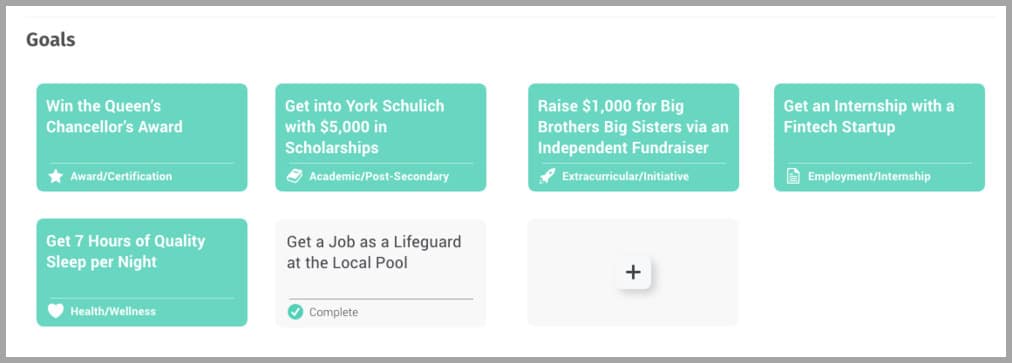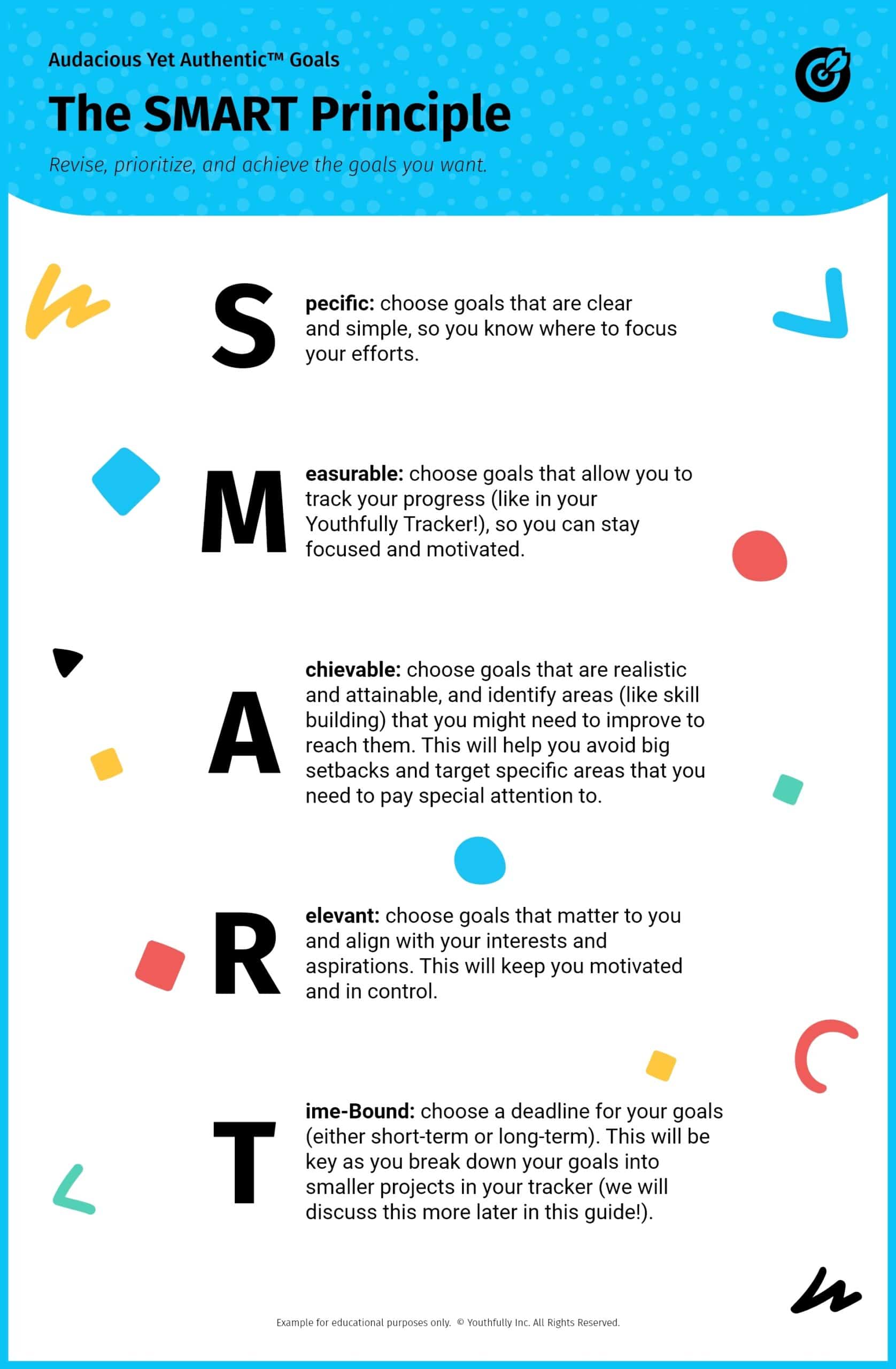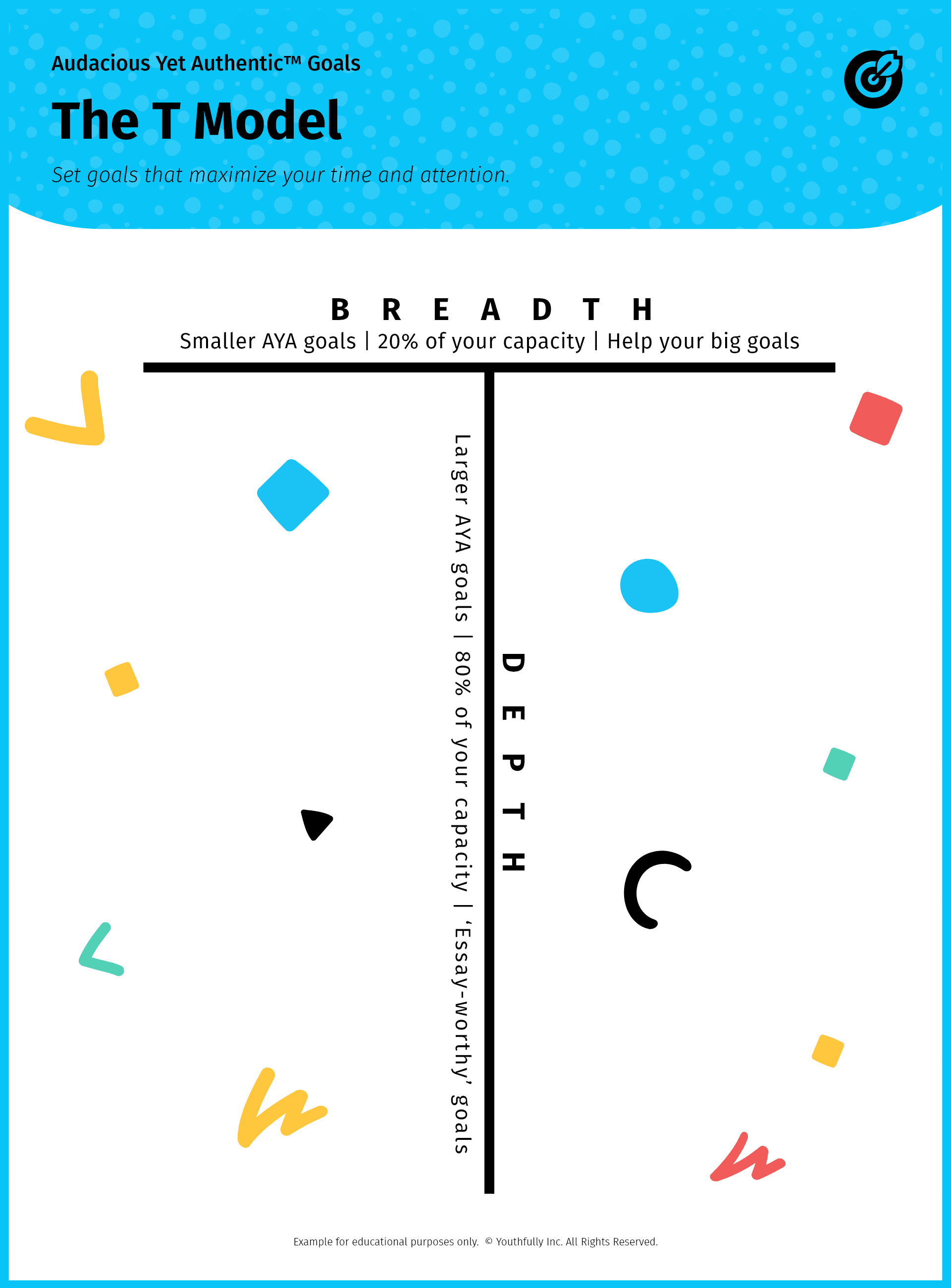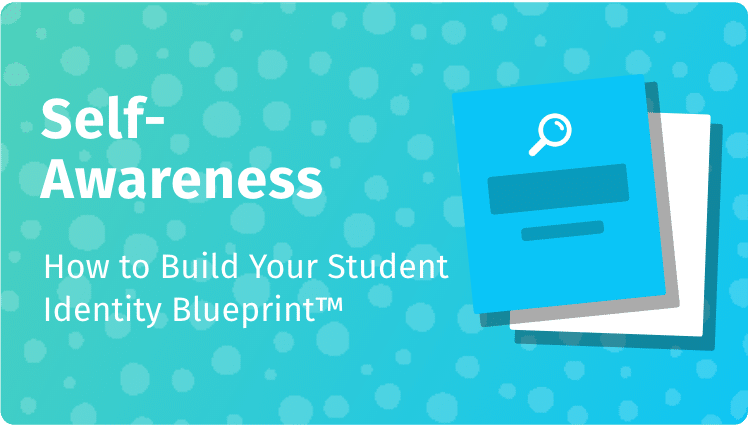The world’s leading organizations, top executives, and Olympic athletes all set goals.
You’re the GOAT in your own life, so why not set yourself up for the best possible future?
If you’re looking for goal setting theory breakdowns, goals setting worksheets and steps, and easy-to-follow goal setting examples, then you’ve come to the right place.
Over the last 10+ years, we’ve learned that very few students set goals, and those who do often choose the ‘wrong’ goals, set them too low, and lack a clear plan of action.
We see so many students who don’t set goals and they frantically come to us at the last minute scrambling to create a high-quality university, job, or scholarship application that tells a unique, compelling, and clear story.
We also see so many high-achieving students who pursue any and every goal they can…
Does this sound like you? You probably think you have the ultimate profile because you’re doing so much, right?
Think again. This actually has the opposite effect because you’ll come across as though you’re doing things just to build your profile.
Focus on quality, rather than quantity. It’ll make your application more clear and memorable.
By working with an experienced and knowledgeable Youth Coach, you’ll learn how to streamline and simplify your goals. You’ll choose goals that are intentional and authentic, and tailored specially to you.
You might be thinking, “That’s easier said than done…I have NO idea how to set or achieve big goals.”
We know that you were never taught how to think strategically to set effective goals in high school and you might not have the project management and organization skills to effectively reach these goals.
Don’t worry! That’s what we’re here for!
Our process is specifically designed to help you identify BIG goals, while also teaching you the skills to manage those goals like projects.
In this guide, we’ll walk you through our Design phase, where you and your coach set “Set Audacious yet Authentic Future Goals and Actions” (very meta that one of your goals is to set goals).
In this phase, we will help you look forward and identify goals that completely synchronize to your Student Identity Blueprint™. Your coach will learn about all the great things you’ve already accomplished, and then help you take that to the next level, while helping you discover new avenues to explore.
But don’t worry — if you aren’t working with a coach, you’ll totally benefit from reading this guide.
If you do want to get started on your journey to awesomeness, connect with a coach now.
To help make things clearer, we’ll use Jane’s journey as an example.
Meet Jane, one of Youthfully’s students:

Our Goal Setting Process (Table of Contents)
- Ideate & Identify Your Goals: Types of goals; Creating unique and authentic goals; and More.
- Revise & Prioritize Your Goals: Focusing your efforts to create a mix of deep and simple goals; The T-Model; and More.
- Create An Action Plan: Using the Tracker; Creating and completing Actions; and More.
Goal Setting Step 1: Ideate and Identify Your Goals
Before you were matched with your coach, you selected some goals for your future. Now, it’s time to refine those goals through 1-on-1 brainstorming sessions with your coach.
After building your Student Identity Blueprint™ and learning a lot about who you are and what you want in your life… maybe some of the goals you set are no longer your goals.
In other words, they aren’t authentic. Your coach will help you think about goals that are more aligned with your true identity and aspirations.
Then, your coach will encourage you to think bigger and get those goals to be as audacious as possible.
That’s where we came up with the term Audacious Yet Authentic (AYA) Goals.
But what does that mean exactly?

Authentic Goals
Authentic goals are those that incorporate all the things you’re good at and all the things you love doing. They are aligned to the Student Identity Blueprint™ with your strengths, susceptibilities, values, mission, etc.
These goals represent YOU, both now and in the future.
Many students consciously or subconsciously pursue goals that aren’t THEIRS. In reality, they are somebody else’s goals (like their parents) and they pursue them because they think that’s what they should be doing.
But they aren’t aligned to who they really are.
Pursuing inauthentic goals results in unhappiness once the goal is attained. It’s as simple as that.
When goals are authentic, you’re also more likely to achieve them.
Why? In the words of Steve Jobs:

What did this mean for our student, Jane? When she started working with us, she mentioned she was admitted to this prestigious finance and economics summer program.
“I am super hesitant to accept it because I don’t know if this interests me anymore,” she said. “My parents always pushed me into the world of finance and economics because they are both accountants. I never really felt like I could tell them I wasn’t into it because I’m afraid of disappointing them.”
After reviewing her Blueprint, her coach suggested that she save her time and energy and devote herself to something that was more authentic. Her coach knew, from her Blueprint, that she loved books and storytelling.
So her coach asked if she was part of a book club. “No, but my mom is,” she said.
“Do teens even have book clubs?” her coach asked. “I don’t think so,” Jane replied. They discussed how Jane’s love for reading is a rare thing in her generation because teens have trouble paying attention to something for a long period of time.
“Do you see an opportunity here?” her coach asked. “I think I do! I could start a modern, fun book club for kids my age!”, she said.
Her coach summarized: “Nice! So what I’m hearing is you’re going to completely rethink the concept of a book club, thoughtfully designed for your generation in mind, to inspire youth to read more and build a digital community of like minded readers?”
Authentic goal, check! ☑️
Audacious Goals
Audacious goals are all about choosing goals that are bigger than you ever thought possible.
Most students set small goals and they don’t give themselves permission to think big (or they don’t know how to make it happen). Your coach will help you with this and create a clear plan of action.
We know that you can do anything you set your mind to, and your coach will help get you there.

Back to Jane’s book club example, to make it audacious, her coach asked: “How could you make this book club the largest teen book club in the world?”
That was the beginning of Jane’s Beyond the Pages virtual book club, which grew to over a thousand members, 100,000+ messages sent between members, dozens of books read as a group, and so many more amazing outcomes.
Was this hard for Jane? Absolutely. But because it was AYA, she WANTED to work on it every day after school. That’s the key.
Audacious goal, check! ☑️
Why is Setting Goals Important?: The Six Types of Goals
Under the AYA umbrella, there are six types of goals that your coach will work with you to achieve.
We believe the strongest students pursue a mix of all six types of these goals and our coaches’ job is to help you do the same. We call it the ‘full-student’ approach.
You’ll notice the same six types were used to categorize your achievements in your Student Identity Blueprint™. Achievements are goals that have been realized, but your coach may also see an opportunity to level-up that achievement with a new goal.
These six types of goals are:
- Awareness/Development: These goals focus on learning more about yourself like what you’re good at and what you value, as well as growing your skills and building expertise.
- Academic/Post-Secondary: School-focused goals. This can be taking a specific course, getting a certain GPA, getting into a top-tier program, etc.
- Extracurriculars/Initiatives: Goals for activities that you are (or want to be) involved in outside of the classroom. This could include being a part of a school club, sports team, volunteer opportunity, etc.
- Employment/Volunteering: These goals can be about current employment/internships you have that you want to continue progressing in, or they can be goals for your career. For example, if you are an intern at a local newspaper, you could set the goal to get hired part-time as you complete a program in journalism at school. Or, a goal could be that you want to be an entrepreneur and start your own business.
- Finances/Scholarships: These goals are focused on paying for school, scholarships, bursaries, and other student awards, or managing personal finances.
- Health/Wellness: These are goals for self-care routines or activities that let you take care of your mental and physical health. For example, you could set a goal that you want to run a half marathon or you want to cut down on screen time.
Setting goals in all six of these areas is so important because it will allow you to have well-rounded experience in many areas as you continue to learn what you’re interested in, what’s important to you, and what you want to focus on the most.
Now that you understand AYA and ‘full student’ goals, hop on a call with your coach to set some that you’re excited about and will be proud to accomplish. Then, go ahead and start adding some of those to the Goals section of your Tracker, as seen below:

If you haven’t connected with a coach yet, and you want some support defining your goals and setting a winning game-plan, then click here to get started.
Achieve BIG goals with a reliable mentor.
get a youth coach™Stephanie
Non-profit Founder
Youth Coach™

Goal Setting Step 2: Revise & Prioritize Your Goals
Look, we know you have a lot going on. Between classwork, ECs, university application prep, and actually finding time for a social life, it can be tough to get everything done.
That’s why it’s so important to evaluate which goals require the greatest allocation of your precious time and energy.
We use two methods to revise and prioritize your goals:
Goal Setting Theory: The SMART Principle
You’re smart, and your goals should be too!
When thinking about what you want to achieve and coming up with a plan of execution, make sure you choose goals that are:

Goal Setting Theory: The T Model
We want all your goals to have depth and breadth so that you have well-rounded experience in many things, and a deep focus on just a few.
We also can’t have you pursuing five big goals all at once. That’s why we use the T Model.
In the T model, you are working on a very small number of audacious goals that take slightly longer and more effort to complete (this is the vertical part of the ‘T’), such as launching your own independent leadership project or finding an internship for the summer.
This should be about 80% of your capacity. Another way to frame these are ‘essay-worthy’ goals. In other words, do these experiences have enough depth for you to write a deeply compelling 500-word essay on? This is where most students lack.
Examples include starting a non-profit organization, doing a TED talk, or writing your own book. These will take more time, but the journey to complete them will really shape who you are as a person and set you on the path to a successful future.
The remaining 20% of your capacity should come from smaller goals. Most students already have a ton of smaller goals (the horizontal part of the ‘T’), like taking an online course, volunteering as the captain of a sports team on the weekend, etc. The real key to unlock any value out of smaller goals is to find synergies.
In other words, can a smaller goal help unlock or put you closer to your bigger goal, while adding a different dimension to your list of accomplishments? For example, if you’re starting a digital marketing agency, you can take the Google Analytics Certification, which will not only show as a separate achievement but also support you in delivering more value to your clients.
Here’s how you can visualize the T Model:

Going back to our example with Jane, she set 2-3 big goals, like launching her virtual book club, getting into a top-tier business program, or getting an internship at a well-known publisher in her city (this is the vertical part of the T).
Her smaller goals (the horizontal part of the T) were designed to be achieved quickly and to strategically align with her bigger goals. For example, she took an online course called Book Writing for Beginners or improving her communications skills by writing an article for a local magazine.
By setting both big and smaller goals, you will acquire a deep range of knowledge and experiences that will make you a stronger applicant and contribute to your overall post-secondary success.
Goal Setting Step 3: Create an Action Plan
Beyond writing down your goals, academic research shows that creating an action plan and having someone hold you accountable will greatly increase the likelihood of accomplishing your goals (no matter what the size).
The Goal Setting WorkSheet: Getting to Know the Youthfully Tracker
This is why we designed the Tracker so you can set actions within each goal you’re working on, as well as a due date for each. Most of these actions will be done by you, but some might be meant for your coach (e.g. review draft of email to Professor Brady).
Ideally, you and your coach agree on actions after each coaching session and review the progress of these actions either offline or during the next coaching session.
It’s important to always have your next coaching session scheduled because this creates an accountability model between you and your coach.
We also find it helpful for you to give your mom or dad access to the Tracker, and discuss what you’re working on with them in person. This will further develop a system of support and accountability around you.
Nearly every organization uses a work management system similar to our Tracker—so you’re not only getting a head start on learning this skill before you enter your career, but you’ll also reap the rewards of managing your goals, actions, and documents online with your coach.
REMEMBER: the goals you set don’t have to be purely focused on academics and ECs. We encourage you to set goals for all areas of your life, like mental health and wellness. We want your goals to be holistic (i.e. influencing every aspect of your life).
You Might Also Like

Skills Training
Self Awareness: How to Build Self Awareness Skills & Discover Who You Are
We get it — planning for the future is stressful. With changes in technology, expanded career options, and more competitive… Read more
You’ve Got a Dedicated Coach in Your Corner
While the process of identifying and executing big goals might seem overwhelming, we want you to know that we are here for YOU.
We want to help you discover who you are and improve your skills to help you become a better student and young professional.
For over a decade, we have successfully helped thousands of students achieve more than they ever thought possible.
Our 1-on-1 Youth Coaching fills that gap that most high schools miss. We can help you build self-awareness through probing questions and assessments, set bigger goals to elevate your extracurriculars and future career plans, and improve skills that matter on supplementary applications, such as interviewing, communication, critical thinking, and creativity.
We use a coaching methodology, called ‘full student’ development, that’s been proven to increase your chances of admission to top-tier universities and obtaining competitive jobs/internships.
So, what are you waiting for? Fulfill your post-secondary potential with the mentorship and coaching you’ve always wanted! 🙂
IMPORTANT: Want to share information and/or images from this resource on your own website, blog, article, etc.? Please ensure you reference content of any kind published by Youthfully Inc., in whole or in part, using the following statement: (1) Our Organization (Youthfully Inc.); (2) The title of our content/resource; and (3) the URL to our webpage where the content was originally posted. For example: “Sourced from: Youthfully Inc., ‘Goal Setting for Students: How to Achieve the Goals You Want’, https://youthfully.com/goal-setting-skills-for-students/.”
Not doing so is an infringement of copyright and is illegal. We spend significant time developing resources for students, so please take a few seconds to ensure they are referenced properly.


